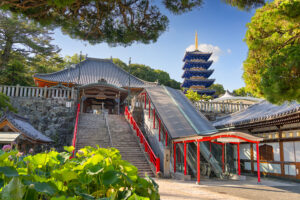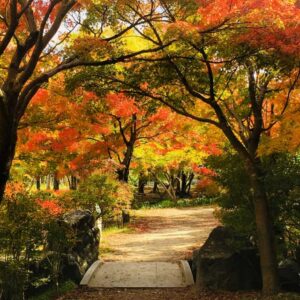Rising gracefully above Kyoto’s skyline, To-ji Pagoda is an architectural wonder and a profound symbol of Japan’s rich cultural heritage. This breathtaking five-story pagoda stands at 57 meters, making it the tallest wooden pagoda in Japan. As you step into the temple grounds, you’re greeted by a tranquil ambiance, where history and spirituality blend seamlessly. It’s more than just a landmark—it’s a gateway to a bygone era, where Buddhist traditions and imperial history still echo through its ancient halls.
A UNESCO World Heritage Gem

Photo from https://elements.envato.com
To-ji Pagoda holds a prestigious place among Kyoto’s many historic treasures. It is part of the city’s UNESCO-listed Historic Monuments, recognized for its outstanding cultural value. Established in 796, the temple has withstood the test of time, witnessing Kyoto’s evolution from an imperial capital to a modern metropolis. It name “To-ji” (東寺) translates to “East Temple.” It was one of two temples built to guard the entrance to Kyoto when it became Japan’s capital in 794. The West Temple (Sai-ji) no longer exists, making To-ji a rare surviving relic of that era.
Within its grounds, you’ll find sacred halls, lush gardens, and priceless Buddhist artifacts that offer a deep dive into Japan’s spiritual past. Whether you’re a history enthusiast or a casual traveler, To-ji’s profound significance makes it a must-visit destination.
Why You Should Visit To-ji Pagoda
Among Kyoto’s countless temples, To-ji stands out for several reasons. First, its towering pagoda is an unmissable sight, especially when reflected in the serene temple pond. Second, the temple’s connection to Shingon Buddhism and its legendary founder, Kukai, adds a layer of spiritual intrigue. Lastly, if you visit on the 21st of any month, you’ll experience the vibrant To-ji Flea Market, a bustling event filled with antiques, crafts, and Kyoto street food. Whether you come for history, culture, or simply to soak in the peaceful atmosphere, To-ji never disappoints.
Planning to visit? find the details below for more information:
- Address: 1 Kujo-cho, Minami-ku, Kyoto 601-8473 Japan
- Phone: 075-691-3325
- Website: https://toji.or.jp/
- Admission Fee: Free aside from the Kondo and Lecture Hall, which require an admission fee of ¥500 for adults, ¥400 for high school students, and ¥300 for junior high school and elementary school students.
- Business Hours: Monday-Sunday 5:00am – 5:00pm
The Origins: A Temple Fit for an Emperor
To-ji Temple traces its roots back to the late 8th century when Emperor Kammu moved Japan’s capital to Kyoto. Along with Sai-ji Temple, it was built as one of the two guardian temples protecting the city’s southern entrance. While Sai-ji no longer exists, To-ji remains, standing as a testament to Kyoto’s deep spiritual foundations. Its establishment marked the beginning of an era when Buddhist temples played an essential role in the city’s governance, culture, and daily life.
Kukai: The Mastermind Behind To-ji’s Legacy

Photo from https://elements.envato.com
In the early 9th century, To-ji underwent a significant transformation when Emperor Saga granted it to Kukai, also known as Kobo Daishi, the founder of Shingon Buddhism. Under his leadership, the temple became a center for esoteric Buddhist teachings, a tradition still practiced today. Kukai’s presence remains strong in To-ji, especially at the Miedo Hall, where visitors pay homage to his legacy. His influence extended beyond religion—he also contributed to Japanese calligraphy, literature, and education, making him one of Japan’s most revered historical figures.
A Blueprint for Japanese Temples
To-ji’s design played a crucial role in shaping the architecture of later temples across Japan. The five-story pagoda is not just a towering masterpiece but an engineering marvel built to withstand earthquakes and natural disasters. The layout of the temple halls follows a sacred mandala pattern, a key concept in Shingon Buddhism. These elements have influenced temple construction for centuries, making To-ji a cornerstone of Japanese architectural heritage.
Architectural Wonders of To-ji

Photo from asiaimages.net
To-ji’s architecture is a masterpiece of traditional Japanese craftsmanship, blending spiritual symbolism with innovative design. Each structure within the temple grounds has its own unique significance, but the Five-Story Pagoda stands as the most iconic feature, renowned for both its towering presence and earthquake-resistant engineering.
- Five-Story Pagoda – As Japan’s tallest wooden pagoda at 57 meters, this striking structure is a marvel of ancient engineering. Unlike other pagodas, its unique design allows it to sway slightly during earthquakes, preventing collapse. It’s not just an architectural wonder—it symbolizes the five elements of Buddhist cosmology: earth, water, fire, wind, and void.
- Main Hall (Kondo Hall) – This hall is a treasure trove of Buddhist art, housing some of the most revered statues in Japan. Unlike many temple halls, To-ji’s Kondo blends influences from both Chinese and Japanese styles, creating a grand yet serene atmosphere.
- Lecture Hall (Kodo Hall) – Step inside, and you’ll find an awe-inspiring arrangement of esoteric Buddhist deities forming a three-dimensional mandala. This hall’s layout is one of the finest representations of Shingon Buddhist teachings, making it a spiritual centerpiece of To-ji.
- Miedo Hall – Dedicated to Kukai, this hall is a deeply sacred space for followers of Shingon Buddhism. Its significance lies not just in its function but in its historical relics, some of which date back to the Heian period.
- Gardens & Surroundings – Unlike many temple gardens designed strictly for meditation, To-ji’s grounds balance tranquility with seasonal vibrance. Whether framed by cherry blossoms in spring or fiery maple leaves in autumn, the pagoda always offers a breathtaking sight.
When to Visit: The Best Seasons for To-ji’s Magic
No matter the time of year, To-ji Pagoda offers a breathtaking experience, but certain seasons elevate its beauty to an entirely new level. From the delicate charm of cherry blossoms to the fiery hues of autumn leaves, each visit brings a unique perspective on Kyoto’s ever-changing landscape. Here’s what makes each season special:
- Spring (Cherry Blossom Season) – Soft pink sakura blooms frame the pagoda, creating a picture-perfect scene straight out of a painting.
- Autumn (Koyo Season) – The temple transforms into a vibrant canvas of red and gold leaves, offering a stunning backdrop for photographers and nature lovers.
- New Year & Special Events – Experience Hatsumode, the first temple visit of the year, or witness special ceremonies that bring To-ji’s spiritual traditions to life.
Things to Do at To-ji
To-ji isn’t just about history—it’s a place to explore, reflect, and soak in Kyoto’s charm. From peaceful strolls to vibrant markets, here’s how to make the most of your visit:
- Take a Leisurely Stroll – Wander through the temple grounds, admire the intricate wooden architecture, and watch as the pagoda reflects beautifully in the pond.
- Shop at the To-ji Flea Market – Held on the 21st of each month, this lively market is a treasure trove of antiques, vintage kimono, handmade crafts, and delicious Kyoto specialties.
- Find Your Zen – Pause for meditation or quiet reflection in the temple’s peaceful gardens, a rare moment of stillness in the heart of Kyoto.
- Capture the Perfect Shot – Whether it’s a sunrise silhouette or an autumn foliage frame, every corner of To-ji offers an unforgettable photography opportunity.
Practical Travel Tips
Getting There
Reaching To-ji is easy, whether you prefer a quick train ride or a scenic bus journey through Kyoto. Here’s how you can get there:
- By Train: Take the JR or Kintetsu line to Kyoto Station, then walk about 15 minutes to reach the temple.
- Riding a Bus: Several Kyoto city buses stop near To-ji, making it easily accessible from various parts of the city.
7 Temple Etiquette: Respecting the Sacred Space
To-ji is more than a tourist attraction—it’s a place of deep spiritual significance. Observing proper etiquette ensures a respectful and meaningful visit for both you and others. Here are some essential guidelines to follow:
- Speak softly – Maintain a quiet and peaceful atmosphere, especially in prayer and meditation areas.
- Avoid touching sacred objects – Statues, relics, and altars hold deep religious meaning and should not be handled unless explicitly allowed.
- Follow photography rules – Some areas prohibit photography or flash use to preserve the artifacts and respect worshippers.
- Dress modestly – While there’s no strict dress code, covering shoulders and avoiding overly casual attire is a sign of respect.
- Remove your shoes – In certain temple halls, you may be required to take off your shoes before entering. Look for signs or follow the lead of others.
- Refrain from eating or drinking in sacred areas – Keep food and beverages away from prayer halls and important monuments.
- Be mindful of personal space – If participating in rituals or observing ceremonies, stand at a respectful distance and avoid disrupting the flow of worshippers.
By following these simple customs, you’ll not only show respect for To-ji’s cultural heritage but also enhance your own experience of this sacred site.
What to Bring & Wear
- Comfortable walking shoes for exploring the expansive temple grounds.
- Modest attire out of respect for the spiritual environment.
- A reusable water bottle to stay hydrated while being eco-friendly.
- A camera or smartphone to capture the pagoda’s beauty.
3 Nearby Attractions to Explore After To-ji Pagoda
After immersing yourself in the history and beauty of To-ji Pagoda, why not continue your Kyoto adventure? Here are some fantastic nearby attractions worth visiting:
1. Kyoto Aquarium- 20 min walk from the Pagoda

Photofrom pop-japan.com
Just a short walk from To-ji, Kyoto Aquarium offers a fascinating glimpse into Japan’s aquatic life. It features exhibits on local river ecosystems, playful seals, and a large dolphin stadium where visitors can enjoy entertaining marine shows. The jellyfish display and interactive touch pools make it a great spot for both kids and adults.
Find the details below for more information:
- Address: 梅小路公園, 内, 35-1 Kankijicho, Shimogyo Ward, Kyoto, 600-8835, Japan
- Phone: 075-354-3130
- Website: https://www.kyoto-aquarium.com/index.html
- Admission Fee: General Admission for Adults is 2,400 yen, High school student is 1,800 yen, Junior to elementary student is 1,200 yen and infant is 800 yen.
- Business Hours: Monday-Sunday 10:00 AM -18:00 PM (Admission is open until 5pm)
2. Kyoto Railway Museum – 25 min walk from the Pagoda

Photo from Kyoto Railway Museum website
For train enthusiasts and history lovers alike, the Kyoto Railway Museum is a must-visit. This impressive museum showcases Japan’s rich railway history with real locomotives, interactive exhibits, and even a turntable demonstration of steam engines. Visitors can step inside vintage trains and learn how Japan’s railways shaped modern transportation.
Find the details below for more information:
- Address: Kankijicho, Shimogyo Ward, Kyoto, 600-8835, Japan
- Phone: +81-570-080-462
- Website: https://www.kyotorailwaymuseum.jp/
- Admission Fee: General admission (18 years and older): 1,500 yen, University and high school students: 1,300 yen, Junior high and elementary school students: 500 yen, Children (3 years and older): 200 yen.
- Business Hours: Monday-Tuesday and Thursday to Sunday 10:00 a.m. to 5:00 p.m.(No admission after 4:30 p.m.)
- Closed : Every Wednesday, Year-end through New-Year season (12/30 to 1/1)
3. Umekoji Park – 15 min walk from the Pagoda

Photo from www.japan-experience.com
If you’re looking for a peaceful green space to unwind, head to Umekoji Park, located near both the aquarium and railway museum. This spacious park is perfect for a relaxing stroll, featuring seasonal flower displays, shaded picnic spots, and a charming pond. It’s an ideal place to take a break and soak in Kyoto’s natural beauty.
Find the details below for more information:
- Address: 56-3 Kankijicho, Shimogyo Ward, Kyoto, 600-8836, Japan
- Phone: 075-352-2500
- Website: https://www.kyoto-ga.jp/umekouji/index.html
- Admission Fee: Free
- Business Hours: Monday-Sunday, 24 hours
These nearby attractions make for a great addition to your visit to To-ji Pagoda, offering a mix of nature, history, and family-friendly experiences!
Must-Try Foods Near To-ji Pagoda
Exploring To-ji is even better with a taste of Kyoto’s culinary delights. From sweet treats to savory specialties, here are some must-try foods:
| Food Name | What Makes It Unique (Taste & Appearance) | Best Way to Enjoy It |
| Yatsuhashi | A Kyoto specialty made from rice flour, often flavored with cinnamon or matcha. It’s soft and chewy when raw, crispy when baked. | Pair with green tea for an authentic Kyoto experience. |
| Tofu Dengaku | Grilled tofu skewers coated with a savory-sweet miso glaze, offering a rich umami flavor. | Eat it hot off the grill for the best texture and flavor. |
| Matcha Soft Serve | Vibrant green, creamy ice cream infused with Kyoto’s high-quality matcha, balancing bitterness with subtle sweetness. | Enjoy on a warm day while strolling through the temple grounds. |
| Nishin Soba | A comforting bowl of buckwheat noodles in a delicate dashi broth, topped with marinated herring that adds a sweet-savory depth. | Savor slowly to appreciate the umami-rich broth and tender fish. |
| Taiyaki | A crispy, golden fish-shaped pastry filled with red bean paste or custard, offering a satisfying contrast between crunchy exterior and soft filling. | Eat it fresh for the perfect crunch and warmth. |
| Yuba (Tofu Skin) | Delicate, silky tofu skin, a Kyoto specialty with a mild, nutty flavor, often served in soups or as sashimi. | Dip in soy sauce or enjoy in a light dashi broth. |
These delicious Kyoto treats add an extra layer of enjoyment to your visit to To-ji Pagoda!
Is To-ji Pagoda Worth Visiting? Without a Doubt!

Photo from https://elements.envato.com
To-ji Pagoda is not just a historic landmark—it’s a gateway to Japan’s rich spiritual and architectural heritage. Standing beneath its towering five-story structure, you’ll feel the weight of over a thousand years of history. Whether you’re drawn by its breathtaking design, intrigued by its deep connection to Shingon Buddhism, or eager to explore the vibrant flea market, To-ji offers an experience that lingers long after your visit.
If Kyoto is on your travel list, this iconic temple deserves a top spot. Step into its timeless beauty and discover a piece of Japan’s cultural soul that will leave you inspired!
Frequently Asked Questions (FAQ)
Can you enter the five-story pagoda?
The pagoda’s interior is not open to the public on a regular basis, but special openings are held a few times a year, allowing visitors to view its sacred Buddhist statues and artwork.
Is there a dress code for visiting To-ji?
While there is no strict dress code, modest clothing is recommended out of respect for the temple’s spiritual significance. Comfortable walking shoes are also advisable.
How long should I spend at To-ji Temple?
A visit typically takes one to two hours, depending on whether you explore the halls, gardens, and flea market. If you enjoy photography or quiet reflection, you may want to stay longer.
Can I take photos inside the temple halls?
Photography is allowed in some areas but prohibited inside certain temple halls to protect sacred artifacts. Always check for signage or ask temple staff before taking pictures.
Is To-ji Temple accessible for wheelchair users?
Yes, the temple grounds are generally wheelchair-friendly, with paved paths and ramps. However, some older structures may have steps or uneven surfaces.
Are there guided tours available at To-ji?
Yes, some guided tours—both in-person and audio guides—are available to enhance your visit. If you’re interested in detailed history and Buddhist symbolism, joining a tour is a great option.
Can I participate in any temple activities?
While To-ji is mainly a sightseeing temple, visitors can sometimes attend Buddhist ceremonies, seasonal festivals, and meditation sessions—especially during special occasions.

